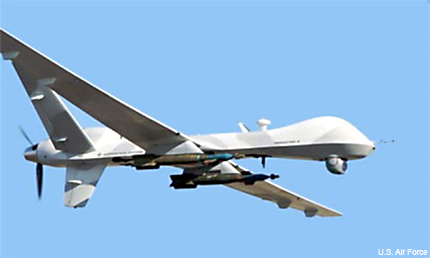Air Force looking for low-cost, disposable attack drones
By relaxing its usual requirements, the service is hoping to make UAS inexpensive enough so that their loss could be "tolerated."

The Reaper currently costs about $13 million each.
The military has for some time been expecting the friendly skies to become a little less friendly, particularly with regard to unmanned aerial systems operating in increasingly contested environments. One way to deal with that is to maintain control in the electromagnetic spectrum that drones rely on. Another possibility is to have drones that are cheap enough that they become somewhat expendable.
That’s one reason the Air Force is looking for lower-cost UAS. The service has issued a Broad Agency Announcement soliciting technology that would allow for long-range, high-speed unmanned aircraft with strike capability but with a price tag lower than what it pays for its current fleet. The solicitation says it wants the UAS for operations “where forward basing is difficult or prohibited.”
The MQ-9 Reaper, the Air Force’s primary long-range intelligence, surveillance and reconnaissance (ISR) and strike UAS, costs about $13 million each, not counting the ground control station it is operated from. That’s a lot less than manned aircraft such as the F-35, which costs about $148 million each for the Air Force version (and a lot more for the Marines and Navy versions), but $13 million still is nothing to sneeze at.
The Air Force notes that aircraft costs are rising, driven by a focus on performance, reliability and durability. To date, the military has acquired UAS with long lifecycles, just as it does with manned aircraft. The service wants to look into trading off some of those attributes in favor of lowering the cost, so that “loss of aircraft could be tolerated.” The Air Force suggests that lowering the bar on its usual requirements could lead to innovations in design, and allow for the use of commercial technologies and manufacturing techniques that could cut costs.
In addition to making them more-or-less disposable—although the Air Force would still prefer not to lose them at all—relatively inexpensive drones also could also provide strength in numbers, allowing the Air Force to send fleets of them into an area, making it more difficult and expensive for an adversary to shoot them down.
The solicitation says the Air Force is willing to spend about $7.45 million for a 30 month effort to “design, develop, assemble, and test a technical baseline for a high speed, long range, low cost, limited life strike UAS.” However, it does note that at the moment, the amount is just an estimate and the program’s direction is subject to change.



